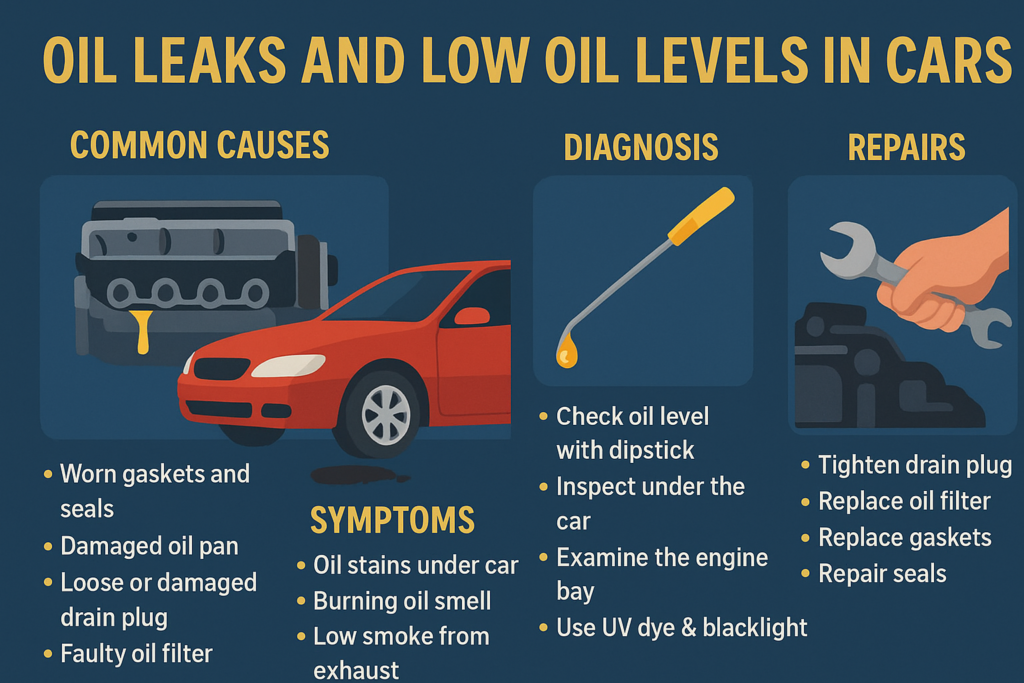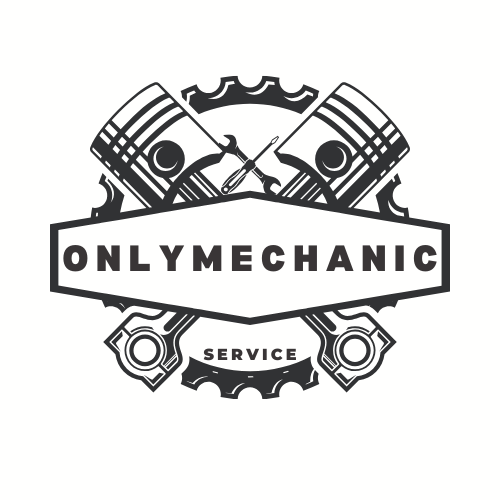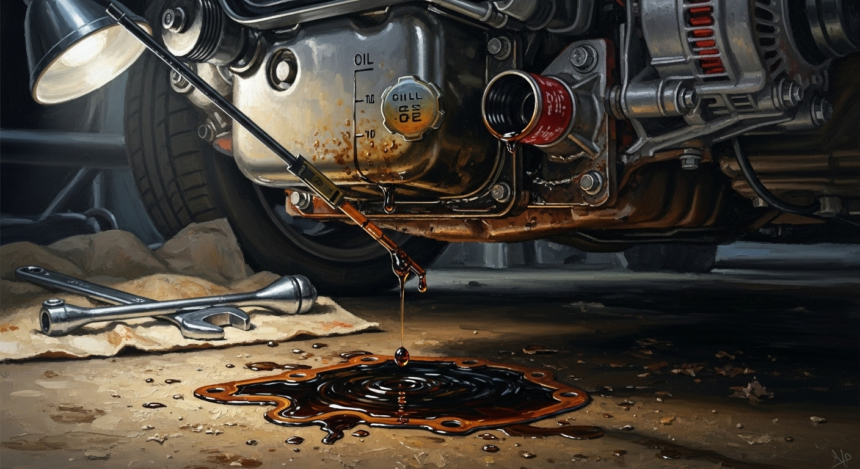Introduction: Why Oil is the Lifeblood of Your Engine
Engine oil does far more than just lubricate parts—it’s a critical component for engine health. It reduces friction, prevents metal-to-metal contact, removes heat from hot engine parts, and carries away tiny contaminants. Without sufficient oil, even the strongest engines will fail in a matter of minutes.
Oil leaks and low oil levels are among the most common automotive problems worldwide. While some leaks are easy to fix, others can point to serious mechanical wear. If left unattended, they can cause overheating, severe wear, and even complete engine seizure.
Common Causes of Oil Leaks
Oil leaks occur when oil escapes the sealed lubrication system. Here are the most common culprits:
1. Worn Gaskets and Seals
Over time, rubber and silicone gaskets degrade due to heat cycles and oil exposure.
- Valve cover gasket – Located at the top of the engine; leaks here often cause oil to pool in spark plug wells.
- Oil pan gasket – Positioned at the bottom; leaks here cause oil to drip directly onto the road.
- Crankshaft and camshaft seals – Leaks from these seals can spread oil across belts and pulleys.
2. Damaged Oil Pan
The oil pan sits low beneath the engine, making it vulnerable to road debris. A dent or crack can lead to slow leaks or sudden oil loss.
3. Loose or Damaged Drain Plug
The oil drain plug is removed during every oil change. Over-tightening can strip threads, while under-tightening allows oil to seep out.
4. Faulty Oil Filter
A defective or improperly installed filter can leak from the gasket seal or housing. This is common after rushed oil changes.
5. PCV System Malfunction
The Positive Crankcase Ventilation (PCV) system regulates pressure inside the engine. A clogged PCV valve causes pressure buildup, forcing oil past seals and gaskets.
Causes of Low Oil Levels Without Visible Leaks
Sometimes your oil level drops but you see no oil stains under the car. This can happen due to:
- Oil burning in the combustion chamber – Caused by worn piston rings or valve seals.
- Turbocharger oil seal failure – Turbos operate at extreme temperatures and pressures, accelerating oil consumption.
- High engine mileage – Older engines naturally consume more oil between changes.
- Extended oil change intervals – Oil breaks down over time, causing evaporation and consumption.
Symptoms of Oil Leaks and Low Oil Levels
1. Oil Stains Under the Car
Dark brown or black spots on your driveway indicate an active leak.
2. Burning Oil Smell
If leaking oil hits a hot exhaust manifold, you’ll smell burning oil, sometimes accompanied by light smoke from under the hood.
3. Blue Smoke from the Exhaust
This means oil is entering the combustion chamber and burning with fuel—often due to internal engine wear.
4. Low Oil Pressure Warning Light
A red oil can symbol means your engine is in danger. Stop driving immediately and check oil levels.
5. Knocking or Tapping Noises
When oil levels drop too low, engine parts are starved of lubrication, producing knocking or ticking sounds.
How to Diagnose an Oil Leak
A proper diagnosis helps determine whether you can fix the problem yourself or need a mechanic.
- Check the Dipstick – Ensure the oil level is between the min and max marks.
- Inspect the Engine Bay – Look for fresh oil around gaskets, seals, and the filter.
- Check Underneath the Car – Use a flashlight to look at the oil pan and drain plug.
- Use UV Dye and a Blacklight – Mechanics add a fluorescent dye to trace hidden leaks.
- Inspect the PCV System – Remove and shake the PCV valve; replace if clogged.
Repair Solutions for Oil Leaks and Low Oil Levels
DIY Fixes
- Tighten the oil drain plug to manufacturer torque specs.
- Replace a leaking oil filter and apply fresh oil to the gasket before installation.
- Top up with the correct oil grade listed in your owner’s manual.
Professional Repairs
- Gasket replacement – Valve cover or oil pan gasket replacements typically cost $100–$300.
- Seal replacement – Crankshaft or camshaft seals may require engine disassembly.
- PCV valve replacement – A clogged valve can be swapped out for $20–$60.
- Internal repairs – If oil burning is due to worn piston rings, expect major engine work.
Preventing Oil Leaks and Low Oil Levels
Prevention is far cheaper than repair.
- Check oil levels monthly – More often if your engine is older.
- Change oil and filter on schedule – Follow your manufacturer’s recommendations.
- Use high-quality engine oil – Stick to the viscosity grade specified in the manual.
- Inspect seals and gaskets during service – Replace them at the first sign of wear.
- Avoid over-tightening oil plugs and filters – Stripped threads are expensive to repair.
The Cost of Ignoring the Problem
An oil leak repair might cost $50–$300, depending on the source. Ignoring it could lead to:
- Bearing failure – Worn crankshaft bearings can destroy the engine bottom end.
- Overheating – Without lubrication, engine heat skyrockets.
- Cylinder wall damage – Scoring reduces compression and power.
- Engine seizure – Total replacement may cost $3,000–$7,000.
In other words: fixing an oil leak early can save you thousands.

Final Thoughts
Oil leaks and low oil levels aren’t just messy—they’re dangerous to your engine’s health. Regular checks, prompt repairs, and high-quality oil are the best defenses against catastrophic damage.
If you notice stains, smells, smoke, or warning lights, don’t ignore them. A small leak today can become a blown engine tomorrow.



Outstanding attention to detail, made our place look brand new again. Using for all future moves. Really impressed.
We are looking for partnerships with other businesses for mutual promotion. Please contact us for more information!
Business Name: Sparkly Maid NYC Cleaning Services
Address: 447 Broadway 2nd floor #523, New York, NY 10013, United States
Phone Number: +1 646-585-3515
Website: https://sparklymaidnyc.com
We pay $10 for a google review and We are looking for partnerships with other businesses for Google Review Exchange. Please contact us for more information!
Business Name: Sparkly Maid NYC Cleaning Services
Address: 447 Broadway 2nd floor #523, New York, NY 10013, United States
Phone Number: +1 646-585-3515
Website: https://sparklymaidnyc.com
We pay $10 for a google review and We are looking for partnerships with other businesses for Google Review Exchange. Please contact us for more information!
Business Name: Sparkly Maid NYC Cleaning Services
Address: 447 Broadway 2nd floor #523, New York, NY 10013, United States
Phone Number: +1 646-585-3515
Website: https://sparklymaidnyc.com
We pay $10 for a google review and We are looking for partnerships with other businesses for Google Review Exchange. Please contact us for more information!
Business Name: Sparkly Maid NYC Cleaning Services
Address: 447 Broadway 2nd floor #523, New York, NY 10013, United States
Phone Number: +1 646-585-3515
Website: https://sparklymaidnyc.com
I don’t ordinarily comment but I gotta state thankyou for the post on this special one : D.
We pay $10 for a google review and We are looking for partnerships with other businesses for Google Review Exchange. Please contact us for more information!
Business Name: Sparkly Maid NYC Cleaning Services
Address: 447 Broadway 2nd floor #523, New York, NY 10013, United States
Phone Number: +1 646-585-3515
Website: https://maps.app.goo.gl/u9iJ9RnactaMEEie8
Regards for all your efforts that you have put in this. very interesting information.
Hey very nice site!! Guy .. Beautiful .. Amazing .. I’ll bookmark your blog and take the feeds also…I’m satisfied to find so many helpful information here within the submit, we want develop more techniques in this regard, thank you for sharing.
Very instructive and good bodily structure of subject matter, now that’s user genial (:.
We pay $10 for a google review and We are looking for partnerships with other businesses for Google Review Exchange. Please contact us for more information!
Business Name: Sparkly Maid NYC Cleaning Services
Address: 447 Broadway 2nd floor #523, New York, NY 10013, United States
Phone Number: +1 646-585-3515
Website: https://maps.app.goo.gl/u9iJ9RnactaMEEie8
I envy your piece of work, thanks for all the interesting content.
We pay $10 for a google review and We are looking for partnerships with other businesses for Google Review Exchange. Please contact us for more information!
Business Name: Sparkly Maid NYC Cleaning Services
Address: 447 Broadway 2nd floor #523, New York, NY 10013, United States
Phone Number: +1 646-585-3515
Website: https://maps.app.goo.gl/u9iJ9RnactaMEEie8
We pay $10 for a google review and We are looking for partnerships with other businesses for Google Review Exchange. Please contact us for more information!
Business Name: Sparkly Maid NYC Cleaning Services
Address: 47 Broadway 2nd floor #523, New York, NY 10013, United States
Phone Number: +1 646-585-3515
Website: https://maps.app.goo.gl/u9iJ9RnactaMEEie8
Hello just wanted to give you a quick heads up. The words in your post seem
to be running off the screen in Opera. I’m not sure if this is a formatting issue or something to do with
web browser compatibility but I thought I’d post to let you know.
The style and design look great though! Hope you get the problem solved soon. Kudos
Hello There. I discovered your blog using msn. This is a really neatly written article. I will make sure to bookmark it and return to learn more of your useful information. Thanks for the post. I’ll definitely comeback.
Its excellent as your other articles : D, thankyou for posting.
Exactly what I was searching for, thanks for putting up.
Wow! Thank you! I continually wanted to write on my website something like that. Can I take a part of your post to my website?
You made some good points there. I did a search on the subject matter and found most people will go along with with your blog.
Very excellent visual appeal on this internet site, I’d rate it 10 10.
Its like you read my mind! You seem to know so much about this, like you wrote the book in it or something. I think that you can do with a few pics to drive the message home a bit, but other than that, this is excellent blog. An excellent read. I’ll definitely be back.
You made various fine points there. I did a search on the matter and found most folks will have the same opinion with your blog.
I think this website has some very excellent info for everyone. « He is able who thinks he is able. » by Buddha.
Hi, Neat post. There’s a problem together with your website in internet explorer, would check this?K IE nonetheless is the market chief and a good element of other folks will pass over your fantastic writing due to this problem.
Great blog here! Also your web site loads up very fast! What host are you using? Can I get your affiliate link to your host? I wish my website loaded up as quickly as yours lol
Some truly superb blog posts on this site, regards for contribution. « Gratitude is not only the greatest of virtues, but the parent of all others. » by Cicero.
F*ckin’ tremendous things here. I’m very satisfied to peer your post. Thanks so much and i am taking a look ahead to contact you. Will you please drop me a mail?
Heya i’m for the first time here. I came across this board and I find It truly useful & it helped me out a lot. I hope to give something back and help others like you helped me.
What i do not understood is in fact how you’re now not really a lot more well-preferred than you may be right now. You’re so intelligent. You already know therefore significantly with regards to this topic, produced me individually believe it from a lot of numerous angles. Its like women and men are not interested except it is one thing to do with Lady gaga! Your own stuffs outstanding. Always maintain it up!
This really answered my problem, thank you!
I am impressed with this site, real I am a big fan .
Enjoyed looking at this, very good stuff, thanks.
I am now not certain where you’re getting your information, however great topic. I must spend a while finding out much more or figuring out more. Thanks for fantastic information I used to be on the lookout for this information for my mission.
Wonderful blog! I found it while browsing on Yahoo News. Do you have any tips on how to get listed in Yahoo News? I’ve been trying for a while but I never seem to get there! Appreciate it
Hello there I am so excited I found your blog page, I really found you by mistake, while I was researching on Google for something else, Anyways I am here now and would just like to say kudos for a incredible post and a all round thrilling blog (I also love the theme/design), I don’t have time to browse it all at the minute but I have saved it and also added in your RSS feeds, so when I have time I will be back to read much more, Please do keep up the awesome job.
Hey very nice website!! Man .. Excellent .. Amazing .. I will bookmark your website and take the feeds also…I’m happy to find so many useful information here in the post, we need work out more techniques in this regard, thanks for sharing. . . . . .
Good day! Do you know if they make any plugins to protect against hackers? I’m kinda paranoid about losing everything I’ve worked hard on. Any recommendations?
Your place is valueble for me. Thanks!…
Hi there! This is kind of off topic but I need some advice from an established blog. Is it very difficult to set up your own blog? I’m not very techincal but I can figure things out pretty quick. I’m thinking about setting up my own but I’m not sure where to begin. Do you have any tips or suggestions? Thank you
I really like your blog.. very nice colors & theme. Did you make this website yourself or did you hire someone to do it for you? Plz answer back as I’m looking to create my own blog and would like to find out where u got this from. thank you
Great line up. We will be linking to this great article on our site. Keep up the good writing.
Hello! This post could not be written any better! Reading this post reminds me of my old room mate! He always kept talking about this. I will forward this article to him. Fairly certain he will have a good read. Thanks for sharing!
Thanks a lot for sharing this with all of us you actually know what you’re talking about! Bookmarked. Please also visit my site =). We could have a link exchange contract between us!
Hey There. I found your blog using msn. This is a very smartly written article. I’ll be sure to bookmark it and return to read extra of your helpful information. Thank you for the post. I will definitely return.
The next time I read a blog, I hope that it doesnt disappoint me as much as this one. I mean, I know it was my choice to read, but I actually thought youd have something interesting to say. All I hear is a bunch of whining about something that you could fix if you werent too busy looking for attention.
I believe you have remarked some very interesting details , thankyou for the post.
Hello. fantastic job. I did not imagine this. This is a impressive story. Thanks!
Real great visual appeal on this web site, I’d value it 10 10.
Your place is valueble for me. Thanks!…
I like what you guys are up too. Such smart work and reporting! Keep up the superb works guys I¦ve incorporated you guys to my blogroll. I think it will improve the value of my web site 🙂
You are my inspiration , I possess few web logs and often run out from to post .
Hi my friend! I wish to say that this post is amazing, nice written and come with almost all important infos. I would like to see extra posts like this .
I?¦m no longer certain where you’re getting your information, however great topic. I must spend some time learning much more or figuring out more. Thanks for magnificent information I used to be searching for this information for my mission.
I have recently started a site, the info you provide on this site has helped me tremendously. Thanks for all of your time & work.
Can I simply say what a reduction to find someone who really knows what theyre talking about on the internet. You positively know the best way to carry a problem to mild and make it important. More folks need to learn this and perceive this side of the story. I cant believe youre no more popular since you undoubtedly have the gift.
Definitely, what a magnificent site and informative posts, I surely will bookmark your site.All the Best!
Hey, you used to write fantastic, but the last several posts have been kinda boringK I miss your great writings. Past several posts are just a little out of track! come on!
Good info. Lucky me I reach on your website by accident, I bookmarked it.
I don’t even know how I ended up here, but I thought this post was good. I don’t know who you are but certainly you are going to a famous blogger if you aren’t already 😉 Cheers!
Hey! This post could not be written any better! Reading through this post reminds me of my previous room mate! He always kept talking about this. I will forward this page to him. Fairly certain he will have a good read. Thanks for sharing!
Merely wanna input that you have a very decent web site, I enjoy the style and design it really stands out.
Throughout the grand pattern of things you get an A+ with regard to effort and hard work. Where you actually lost me personally was in the facts. As as the maxim goes, details make or break the argument.. And it couldn’t be much more accurate here. Having said that, let me tell you just what exactly did give good results. The article (parts of it) is rather persuasive and that is probably why I am making the effort in order to opine. I do not make it a regular habit of doing that. 2nd, despite the fact that I can certainly see the jumps in logic you make, I am not really certain of exactly how you appear to unite your details which make the actual conclusion. For right now I will yield to your issue however wish in the near future you connect the dots much better.
I’ve learn some just right stuff here. Certainly value bookmarking for revisiting. I wonder how a lot effort you place to create any such excellent informative website.
Great work! This is the type of information that should be shared around the internet. Shame on Google for not positioning this post higher! Come on over and visit my website . Thanks =)
It’s hard to find knowledgeable people on this topic, but you sound like you know what you’re talking about! Thanks
The Pink Salt Trick is a minimalist but effective morning routine: Just drink a glass of lukewarm water mixed with a pinch of Himalayan pink salt as soon as you wake up.
certainly like your website but you need to test the spelling on several of your posts. Several of them are rife with spelling problems and I in finding it very bothersome to tell the reality on the other hand I will certainly come back again.
I have been exploring for a little for any high quality articles or weblog posts on this sort of house . Exploring in Yahoo I finally stumbled upon this web site. Studying this info So i am happy to express that I have an incredibly good uncanny feeling I discovered just what I needed. I most unquestionably will make sure to don?¦t forget this website and provides it a look on a relentless basis.
The Pink Salt Trick is a minimalist but effective morning routine: Just drink a glass of lukewarm water mixed with a pinch of Himalayan pink salt as soon as you wake up.
Some really interesting information, well written and broadly speaking user pleasant.
The Pink Salt Trick is a minimalist but effective morning routine: Just drink a glass of lukewarm water mixed with a pinch of Himalayan pink salt as soon as you wake up.
whoah this blog is magnificent i love reading your articles. Keep up the good work! You know, lots of people are searching around for this info, you can help them greatly.
I think this internet site holds very superb composed content material content.
As I website owner I conceive the content material here is real superb, regards for your efforts.
What’s Happening i am new to this, I stumbled upon this I’ve found It absolutely helpful and it has aided me out loads. I hope to contribute & assist other users like its helped me. Great job.
I envy your piece of work, appreciate it for all the useful content.
The Pink Salt Trick is a minimalist but effective morning routine: Just drink a glass of lukewarm water mixed with a pinch of Himalayan pink salt as soon as you wake up.
Some truly prime content on this site, saved to bookmarks.
Hey there! I know this is kinda off topic but I was wondering if you knew where I could find a captcha plugin for my comment form? I’m using the same blog platform as yours and I’m having difficulty finding one? Thanks a lot!
I like this blog its a master peace ! Glad I observed this on google .